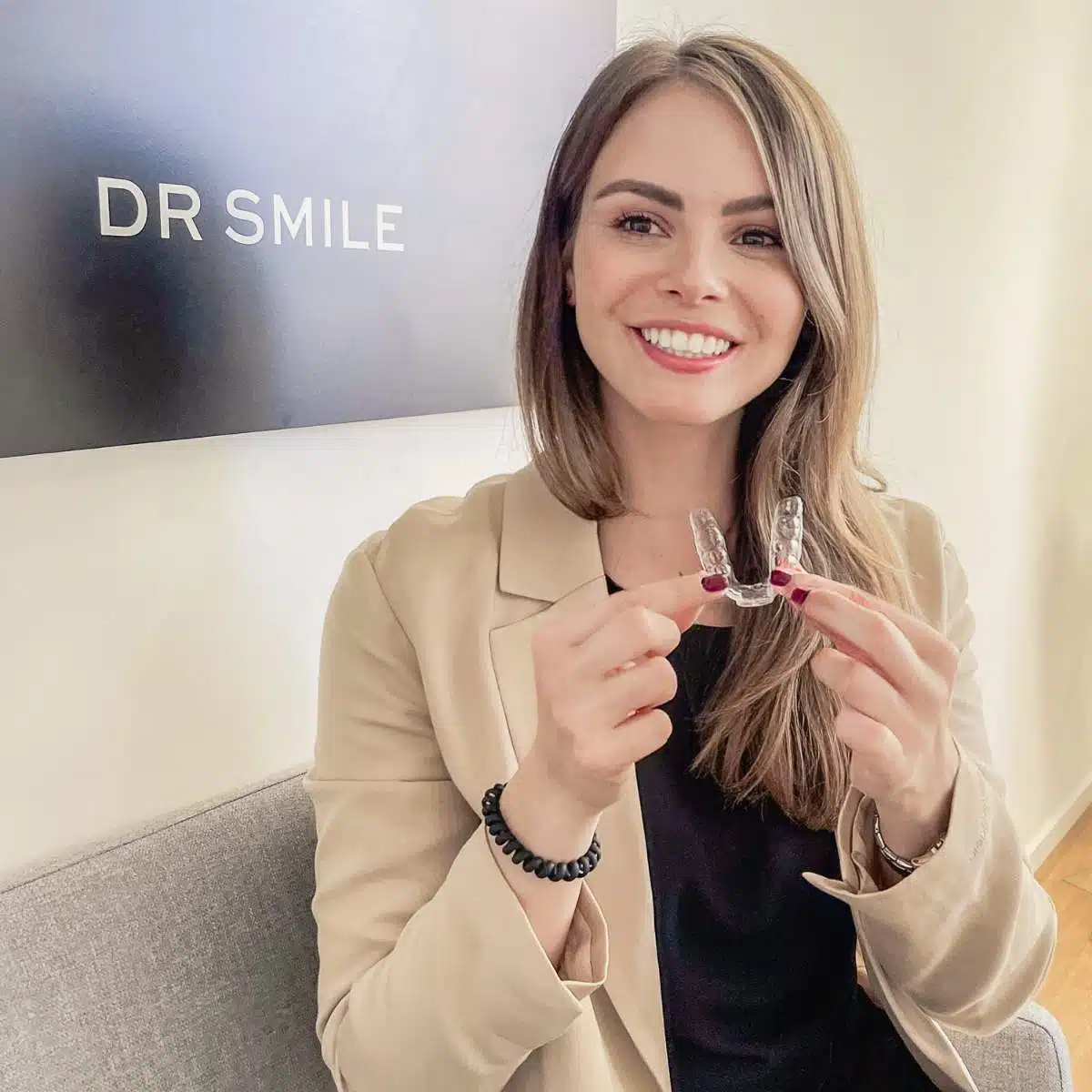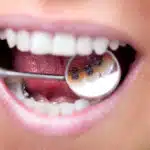Crooked teeth after braces: What to do if the teeth shift again immediately after treatment or even years later?
The correction is complete, the braces no longer need to be worn and the dream of a beautiful smile has finally become reality.
Now the wait is over – the moment that all braces wearers probably dream of from the first day of dental treatment.
But what happens if the teeth start to shift again after the braces have been removed or treatment has been completed?
Unfortunately, this can happen both immediately after treatment and many years later. Was the tooth correction in vain or are there ways to stop the process?
| Get 150 € discount on your dental correction! |

Book a consultation appointment now at a nearby DrSmile partner practice and find out if teeth straightening with aligners is right for you.
The appointment is completely non-binding and does not involve any costs.
With the code “THATSMILE150” you will receive 150 € discount on the treatment.
In this blog post, we talk about what you can do if your teeth shift unexpectedly after treatment with braces.
We explore the reasons for the shifts and provide practical solutions and preventative measures to keep your smile bright.
Stay tuned to learn more about your options and how you can make sure your teeth stay straight and healthy.

Crooked teeth after braces in adulthood
It is a frustrating experience: months or even years of treatment with braces are finally over.
You look forward to a life with a straight, flawless smile. But then the teeth start to shift again.
This phenomenon is not only frustrating, but can also lead to uncertainty about the next steps.
Here you can find out how crooked teeth develop after braces in adulthood and what you can do about it.
Why do teeth shift after braces?
More and more people are deciding to have their teeth corrected with fixed braces or invisible aligners when they reach the age of majority or later in their adult life.
Here it can happen particularly quickly that the teeth shift again after the treatment has been completed. This may have the following reasons:
1. incomplete retention
After removing the braces, it is crucial to wear a retainer as prescribed.
The retainer helps to stabilize the teeth in their new position while the tissue and bone around the teeth strengthen.
If these retention requirements are not met, the teeth may shift back.
There are both fixed and loose retainers. Many aligner providers, such as DrSmile, let their patients choose the type of retention themselves.

Loose retainer
Anyone who opts for a loose retainer must initially continue to wear it around the clock after the teeth have been corrected – ideally for at least as long as the treatment lasted.
Only when you can no longer feel any tension when inserting the retainer after a few hours of wear should the splints only be worn at night.
Retention usually lasts several years – but ideally for a lifetime, as teeth can shift into old age.
Fixed retainers
A fixed retainer, often referred to simply as a “retainer wire”, is a thin wire that is permanently attached to the back of the front teeth.
The wire is usually attached to the lower or upper front teeth and often remains in the mouth for years or even permanently.
As it is attached to the inside of the teeth, it is not visible from the outside, offers a discreet solution and does not interfere with speaking or eating.
| Get 150 € discount on your dental correction! |

Book a consultation appointment now at a nearby DrSmile partner practice and find out if teeth straightening with aligners is right for you.
The appointment is completely non-binding and does not involve any costs.
With the code “THATSMILE150” you will receive 150 € discount on the treatment.
2. natural ageing processes
Over time, teeth tend to shift due to natural ageing processes. This can also affect people who have never worn braces.
For this reason, dentists and orthodontists recommend lifelong retention after orthodontic treatment has been completed.
That sounds very complicated at first. However, modern methods, such as an invisible retainer wire, require only minimal effort.
Removable retainers, which are similar to invisible aligners, are also a good solution.
After a while, they only need to be worn at night and even protect the teeth from wear and tear caused by teeth grinding.
3. tooth pressure and growth
Activities such as thumb sucking, teeth grinding, nail biting, excessive pressure from the tongue when speaking or swallowing, as well as the natural growth of wisdom teeth can exert pressure on the rows of teeth and lead to displacement.
Fortunately, there are individual solutions for each of these problems. In the case of teeth grinding and displacement due to wisdom teeth, for example, a dentist or orthodontist is required.

How can I correct crooked teeth after braces?
Fortunately, there are various ways to move crooked teeth back into the desired position after braces.
1. wearing a retainer
If you did not wear your retainer consistently after the first treatment, wearing it again can help to straighten your teeth.
Discuss with your orthodontist whether a new retainer should be made and how often and for how long you will have to wear it.
Retainers can also be reordered at any time from providers of invisible braces, such as DrSmile.
2. orthodontic follow-up treatment
In some cases, further orthodontic treatment may be necessary to bring the teeth back into the desired position.
This may involve retreatment with braces or the use of invisible aligners such as DrSmile.
3. veneers
If the shift is minor and you are mainly concerned for aesthetic reasons, veneers could offer a solution.
These dental procedures can improve the appearance of your teeth and correct minor irregularities.
However, these are relatively expensive, especially in Europe, and the teeth have to be ground down before treatment, which is not always ideal.
| Get 150 € discount on your dental correction! |

Book a consultation appointment now at a nearby DrSmile partner practice and find out if teeth straightening with aligners is right for you.
The appointment is completely non-binding and does not involve any costs.
With the code “THATSMILE150” you will receive 150 € discount on the treatment.
Crooked teeth after braces in teenage years
Many of us wear braces when we are young in the hope that the results will last a lifetime.
However, it is not uncommon for teeth to shift again in adulthood.
If you find yourself in this situation, you are not alone.
Many of us were so relieved after removing the fixed braces that the retention was completely forgotten after a few months.
There are similar reasons to those described above for teeth shifting again after treatment or even many years later:
- Negligent retention: If the retainer is not worn according to the orthodontist’s instructions, the teeth can move back into their original position or into a new misalignment. This is particularly critical in the months immediately after the braces are removed.
- Natural ageing processes: Our teeth are subject to natural movements and changes throughout our lives. As we age, the teeth can shift due to changes in the jawbone.
- Pressure from bad habits: Habits such as teeth grinding, intense chewing, thumb sucking or using toothpicks can put pressure on the teeth and shift them over the years.

What can I do about crooked teeth after braces in my teenage years?
Even if the teeth were straightened as a teenager and therefore many years ago, there are several ways to move crooked teeth back into the desired position after braces.
1. wear a retainer again
If the treatment was not too long ago and you still have your old retainer (and it still fits), wearing it again could help to stabilize the teeth again.
If the retainer is no longer present, you should make an appointment with your orthodontist to have a new one fitted.
2. renewed orthodontic treatment
Sometimes further orthodontic treatment may be necessary to correct the teeth again.
This can also be a less intensive and shorter treatment, depending on the degree of displacement.
A brief conclusion on the topic of crooked teeth after braces
Crooked teeth after braces are naturally annoying. In some cases, however, they can be corrected by wearing retainers regularly.
However, if the treatment is too far back or the teeth have already shifted too much, there are now fortunately discreet alternatives to traditional braces with wires and metal.
For mild and moderate malocclusions, we recommend invisible aligners from DrSmile, which are significantly cheaper than fixed braces and allow you to correct your teeth discreetly.
Click through our further DrSmile articles here with all the important information about the aligner provider.
DrSmile has already produced more than one million aligners and can look back on over 150,000 completed tooth corrections.
DrSmile’s invisible aligners are already available in over 100 partner practices throughout Germany.
The company also offers not only a good price-performance ratio but also a satisfaction guarantee in case you are not one hundred percent happy with the result.
| Get 150 € discount on your dental correction! |

Book a consultation appointment now at a nearby DrSmile partner practice and find out if teeth straightening with aligners is right for you.
The appointment is completely non-binding and does not involve any costs.
With the code “THATSMILE150” you will receive 150 € discount on the treatment.
FAQs on the topic of crooked teeth after braces
Here we answer a few of the most frequently asked questions about crooked teeth after braces.
Why do my teeth shift after wearing braces?
Teeth can shift after braces are removed for several reasons, including natural growth, changes in the jaw, pressure from bad habits like teeth grinding, or not wearing the recommended retainer.
How can I prevent my teeth from shifting after braces?
The best way to prevent teeth from shifting after treatment is to consistently wear a retainer according to your orthodontist’s instructions.
What are the different types of retainers?
There are two main types of retainers: removable retainers, which are worn at night, and fixed retainers, which are permanently attached behind the teeth.
What can I do if my teeth have already shifted?
If there is a slight shift, you may be able to start wearing a retainer again. In the case of more severe displacements, a new orthodontic treatment may be necessary.
Can I use my old retainer if my teeth have shifted?
This depends on how much the teeth have shifted. If the displacement is small, the old retainer may still fit. Otherwise, you will need a new one that is adapted to your current tooth position.




Leave a Reply